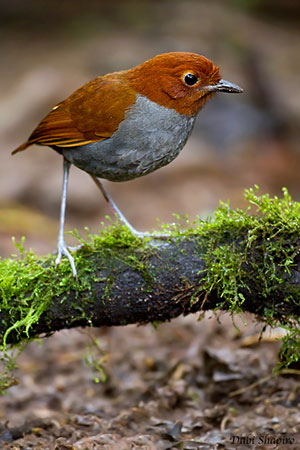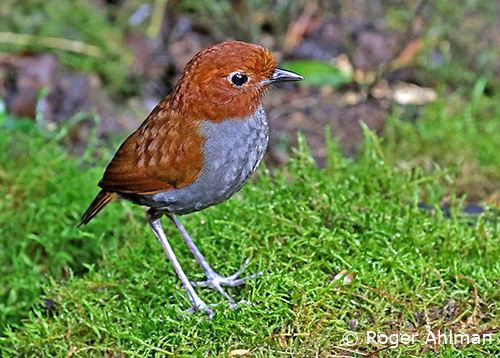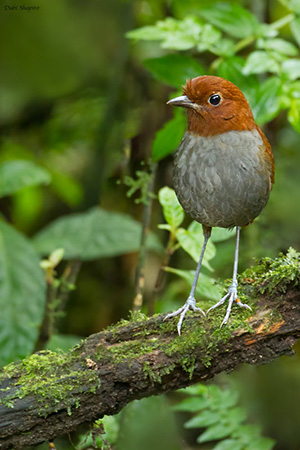
PROTECTION / THREATS / STATUS:
The population of the Bicolored Antpitta is declining since the 20th century and the bird is described as rare and local in the temperate zones of the Andes of Colombia.
This species is threatened by habitat loss. Degradation by deforestation for agriculture and human developments which occurs within the range of the Bicolored Antpitta, clearance of forests for coffee plantations and vegetables, cattle-grazing, and roads which attract many people who settles and farms in previously inhabited areas are very important threats for this species.
The Bicolored Antpitta is protected in some reserves and parks, but it is necessary to protect forested areas on the east Andean slopes.
The population is declining slowly. It is placed in the band 2,500/9,999 individuals, rounded to 1,700/7,000 mature individuals.
But currently, the Bicolored Antpitta is classified as Vulnerable.
Fr: Grallaire bicolore
Ang: Bicolored Antpitta
All: Zweifarben-Ameisenpitta
Esp: Tororoí Bicolor
Ita: Pitta formichiera bicolore
Nd: Tweekleurige Mierpitta
Sd: tvåfärgad myrpitta
Photographers:
Roger Ahlman
Pbase Galleries Peru and Ecuador
Dubi Shapiro
Dubi Shapiro Photo Galleries
Text by Nicole Bouglouan
Sources:
HANDBOOK OF THE BIRDS OF THE WORLD Vol 8 By Josep del Hoyo-Andrew Elliott-David Christie - Lynx Edicions - ISBN: 8487334504
BIRDS OF SOUTH AMERICA – Passerines - by Robert S. Ridgely and Guy Tudor – HELM Field Guides – ISBN: 9781408113424
A GUIDE TO THE BIRDS OF COLOMBIA by Steven L. Hilty and William L. Brown - Princeton University Press – ISBN 069108372X
Neotropical Birds – Cornell Lab of Ornithology
Fatbirder - Grallariidae – Antpittas
CREAGUS@Monterey Bay (Don Roberson)
Wikipedia, the free encyclopaedia
Antpittas and worm-feeders: a match made by evolution?
Bicolored Antpitta
Grallaria rufocinerea
Passeriformes Order – Grallariidae Family
INTRODUCTION:
The Bicolored Antpitta is found in Colombia and NE Ecuador where it frequents the understorey of the dense montane cloud forest at high elevations, up to treeline. It feeds mainly on insects often caught on the ground. The breeding behaviour is unknown but the species is probably monogamous.
The Bicolored Antpitta is threatened by habitat loss caused mainly by deforestation, although it is suspected to be able to adapt and tolerate considerable disturbance. But it is currently listed as Vulnerable.

DESCRIPTION OF THE BIRD:
Biometrics:
Length: 15-16 cm
Weight: 44-45 g
The Bicolored Antpitta male has uniform dark rufous brown head, throat and upperparts.
The underparts are dark grey, with mottled whitish centre of belly.
The blackish bill is thin and very slightly rounded on upper mandible. The eyes are dark brown, with indistinct whitish eye-ring. Legs and feet are pale grey.
The female is browner than male.
The juvenile is not described.
SUBSPECIES AND RANGE:
The Bicolored Antpitta lives on both slopes of the Central Andes region of Colombia (south Antioquia to west Putumayo), and in north Ecuador (Sucumbíos).
We can find two subspecies:
G.r. rufocinerea (described above) occurs in C Andes of Colombia from S Antioquia S to W Huila.
G.r. romeroana is found in S Colombia, S to NE Andes of Ecuador (NW Sucumbíos).
This race has rufous-brown chin and throat, and the whitish mottling is more extensive on the belly.
HABITAT:
The Bicolored Antpitta lives on floor or undergrowth of dense, humid montane forests and less frequently in secondary growth near the tree line. It is usually found between 2,200 and 3,150 metres of elevation and locally around 1,950 metres.
It seems to be more abundant in the lower parts of its range, and it needs forest cover.

CALLS AND SONGS: SOUNDS BY XENO-CANTO
The Bicolored Antpitta utters high-pitched, ascending, clear, whistled “treeeee”, or double “treeeeeaaaa” ending in low slur, at few second intervals. The female regularly replies to her mate and duets can be heard sometimes.
BEHAVIOUR IN THE WILD:
The Bicolored Antpitta feeds mainly on the ground, searching for small invertebrates such as insects and larvae. This species has recently been observed following ant swarms.
The Bicolored Antpitta is terrestrial species. It usually hops and can run easily on the ground.
It is often very hard to see this bird which is more often heard than seen. It calls from perch well concealed in vegetation, near the ground.
It may sometimes come into a small open area or a grassy clearing, in order to feed in the early morning or in late afternoon.
It is usually found alone. However, duets can be heard sometimes between mates, probably during the breeding season.
The flight of the Bicolored Antpitta is low and direct, and the bird usually flies over short distances.
REPRODUCTION OF THIS SPECIES:
The nesting behaviour is poorly known, and only general information is available.
You will find here some information about the nesting behaviour of this family: Page 4
The breeding season occurs in March-May.
The shape of the nest may vary. We can found cup-shaped nest in fork of tree, or simple suspended basket, or sometimes hanging pouches (not much), or in cavities in fallen tree or stump, and even on the ground.
The female lays 2-3 eggs, usually white or cream, sometimes pale blue or brown, with numerous dark spots.
The incubation shared by both adults lasts about 14 to 16 days, and the young fledge 9-12 days after hatching.
